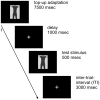Visual adaptation to thin and fat bodies transfers across identity
- PMID: 22905232
- PMCID: PMC3419644
- DOI: 10.1371/journal.pone.0043195
Visual adaptation to thin and fat bodies transfers across identity
Abstract
Visual perception is highly variable and can be influenced by the surrounding world. Previous research has revealed that body perception can be biased due to adaptation to thin or fat body shapes. The aim of the present study was to show that adaptation to certain body shapes and the resulting perceptual biases transfer across different identities of adaptation and test stimuli. We designed two similar adaptation experiments in which healthy female participants adapted to pictures of either thin or fat bodies and subsequently compared more or less distorted pictures of their own body to their actual body shape. In the first experiment (n = 16) the same identity was used as adaptation and test stimuli (i.e. pictures of the participant's own body) while in the second experiment (n = 16) we used pictures of unfamiliar thin or fat bodies as adaptation stimuli. We found comparable adaptation effects in both experiments: After adaptation to a thin body, participants rated a thinner than actual body picture to be the most realistic and vice versa. We therefore assume that adaptation to certain body shapes transfers across different identities. These results raise the questions of whether some type of natural adaptation occurs in everyday life. Natural and predominant exposure to certain bodily features like body shape--especially the thin ideal in Western societies--could bias perception for these features. In this regard, further research might shed light on aspects of body dissatisfaction and the development of body image disturbances in terms of eating disorders.
Conflict of interest statement
Figures



Similar articles
-
Neural adaptation to thin and fat bodies in the fusiform body area and middle occipital gyrus: an fMRI adaptation study.Hum Brain Mapp. 2013 Dec;34(12):3233-46. doi: 10.1002/hbm.22135. Epub 2012 Jul 17. Hum Brain Mapp. 2013. PMID: 22807338 Free PMC article.
-
Altered Visual Adaptation to Body Shape in Eating Disorders: Implications for Body Image Distortion.Perception. 2016 Jul;45(7):725-38. doi: 10.1177/0301006616633385. Epub 2016 Feb 25. Perception. 2016. PMID: 26921409
-
Body-shape adaptation cannot be explained by adaptation to narrow and wide rectangles.Perception. 2012;41(11):1315-22. doi: 10.1068/p7197. Perception. 2012. PMID: 23513618
-
Body size perception and body satisfaction in restrained and unrestrained eaters.Behav Res Ther. 1992 May;30(3):243-50. doi: 10.1016/0005-7967(92)90070-w. Behav Res Ther. 1992. PMID: 1586361 Review.
-
Conceptualizing body dissatisfaction in eating disorders within a self-discrepancy framework: a review of evidence.Eat Weight Disord. 2018 Jun;23(3):275-291. doi: 10.1007/s40519-018-0483-4. Epub 2018 Feb 9. Eat Weight Disord. 2018. PMID: 29423688 Review.
Cited by
-
Experience-dependent reshaping of body gender perception.Psychol Res. 2022 Jun;86(4):1184-1202. doi: 10.1007/s00426-021-01569-4. Epub 2021 Aug 13. Psychol Res. 2022. PMID: 34387745 Free PMC article.
-
Over or Under? Mental Representations and the Paradox of Body Size Estimation.Front Psychol. 2021 Aug 3;12:706313. doi: 10.3389/fpsyg.2021.706313. eCollection 2021. Front Psychol. 2021. PMID: 34413814 Free PMC article. No abstract available.
-
Does repeatedly viewing overweight versus underweight images change perception of and satisfaction with own body size?R Soc Open Sci. 2020 Apr 1;7(4):190704. doi: 10.1098/rsos.190704. eCollection 2020 Apr. R Soc Open Sci. 2020. PMID: 32431856 Free PMC article.
-
Body Size Adaptation Alters Perception of Test Stimuli, Not Internal Body Image.Front Psychol. 2019 Nov 21;10:2598. doi: 10.3389/fpsyg.2019.02598. eCollection 2019. Front Psychol. 2019. PMID: 31824381 Free PMC article.
-
The importance of perceptual experience in the esthetic appreciation of the body.PLoS One. 2013 Dec 4;8(12):e81378. doi: 10.1371/journal.pone.0081378. eCollection 2013. PLoS One. 2013. PMID: 24324689 Free PMC article.
References
-
- Gibson JJ, Radner M (1937) Adaptation after-effect and contrast in the perception of tilted lines. J Exp Psychol 20: 453–467.
-
- McCollough C (1965) The conditioning of color-perception. Am J Psychol 78: 362–378. - PubMed
-
- Addams R (1834) An account of a peculiar optical phenomenon seen after having looked at a moving body. London and Edinburgh Philosophical Magazine and Journal of Science 5: 373–374.
-
- Webster MA, Kaping D, Mizokami Y, Duhamel P (2004) Adaptation to natural facial categories. Nature 428: 557–561. - PubMed
Publication types
MeSH terms
LinkOut - more resources
Full Text Sources

